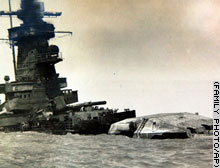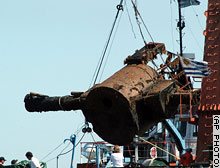 |
 |
| The Graf Spee is slowly sinking in this
photo taken by Friedrich Adolphe, a survivor of the sinking. |
Part of the Graf Spee's command tower
is hoisted aboard a salvage vessel. |
Salvage crew raises key piece of sunken battleship
 |
 |
| The Graf Spee is slowly sinking in this
photo taken by Friedrich Adolphe, a survivor of the sinking. |
Part of the Graf Spee's command tower
is hoisted aboard a salvage vessel. |
MONTEVIDEO, Uruguay (AP) --A salvage team used a floating crane Wednesday
to
raise a key piece of the sunken German battleship Graf Spee, lifting
a 27-ton part of the
command tower after weeks of failed attempts.
Retired Navy Capt. Alberto Braida, a logistics planner for the salvage
operation,
told The Associated Press the team recovered its first significant
part of the ship,
once a symbol of German naval might in the early days of World War
II.
"We've got it!" he said of the large chunk of the communications tower
that once
held sophisticated range-finding equipment for the warship's 11-inch
(280-millimeter) guns.
The vessel -- considered one of the most sophisticated of its time --
prowled the
South Atlantic, sinking as many as nine allied merchant ships before
warships
from Britain and New Zealand crippled it in a December 1939 naval
engagement.
Scuttled by its captain in the River Plate shortly after the battle,
the Graf Spee
has remained for decades in waters less than 25 feet (7.5 meters) deep
only
miles (kilometers) outside the port of Montevideo.
Braida said the team salvaged the the range-finding equipment known
as the
telemeter during a second attempt Wedensday.
Earlier in the day, the recovery team managed to raise the telemeter
but the
supporting cables snapped and the 27-ton piece crashed back into the
water.
An optical instrument, the telemeter was a sophisticated instrument
for its era
that helped gunners improve their aim and hone in on targets up to
35 kilometers
(20 miles) away.
Tricky river currents and fickle winds on the River Plate estuary had
stymied the
salvage team ever since it made a first attempt February 9 to pull
the top of the
command tower from the muddy waters.
The recovery effort is being financed by private investors in Europe
and the
United Sates. The team said it hopes to recover as much of the ship
as possible
in the next three years to place it on display.
Feared by many navies at the outset of the war, the Graf Spee -- a "pocket
battleship" that carried less powerful guns and was smaller than a
conventional
ship of that class -- was tracked down by British forces off the South
American
coast.
The "Battle of the River Plate" began on December 13, 1939, near the
mouth of
the river as the German warship was pursued by a battle group consisting
of two
British warships, HMS Exeter and HMS Ajax, and the HMNZS Achilles of
New
Zealand.
The Graf Spee was crippled in the fight after receiving several direct
hits, and
Capt. Hans Langsdorff decided to take refuge in the Montevideo harbor.
Unable to make the necessary repairs, Langsdorff sank it on December
17, 1939.
The crew was taken by ship to Buenos Aires and the captain committed
suicide
there days later.
Copyright 2004 The Associated Press.